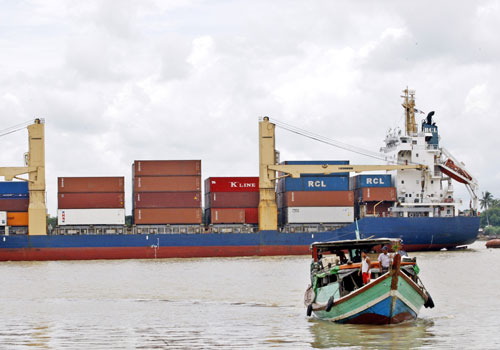Myanmar: Ministry, UMFCCI join calls for import substitution as import rises
The import volume has increased by US$600 million, compared to the same period from the previous fiscal year, according to 2017-18 trade statistics up till May from the Ministry of Commerce (MOC).
Total trade volume from April 1, 2017 to June 2, 2017 is $5.07 billion – an export of $1.9 billion and import of $3.11 billion.
When compared to last year’s performance, export increased by about $100 million while Myanmar imported $600 million more than last year’s two-month period.
“More imports mean more investment. On the other hand, it means more trade deficit.
“I don’t like trade deficit. I don’t want to say either it is an economic growth or it is good,” said U Myo Thet, vice chair of the Republic of the Union of Myanmar Federation of Chambers of Commerce and Industry (UMFCCI).
For imports, capital goods cost around 1 billion, raw materials are $1.2 billion and consumer goods are $756 million which amount to $3117 million of imports.
According to ministry statistics, last year’s imports were capital goods at $1.09 million, raw materials $788.388 million and consumer goods $601.525 million, totalling $2483 million of imports.
Capital goods import increased only by $38 million and thus foreign direct investments did not increase significantly. The increments were $150 million in consumer goods and $400 million in raw materials – more raw imports were seen to be significantly entering into the Myanmar market.
Despite an increased trade volume, trade deficit – which exists every year – will also increase. This year’s deficit for two months is $600 million. Every developing country has to face trade deficits and, under current circumstances, Myanmar will continue to experience a deficit, MOC assistant secretary U Khin Maung Lwin explained.
However, the downsides of a trade deficit are inflation, dollar appreciation and kyat depreciation. Only when exports have increased, will the economy grow. Trade volume improvement will last only for a short term and it can become sluggish during the rainy season, businesses told The Myanmar Times.
This year, trade volume has improved by $96 million – $1.9 billion when compared to last year’s $1.8 billion. More exports are needed to reduce the trade deficit.
Trade promotion is being prioritised and implemented by the MOC under the new government. In order to reduce the deficit, both import-substitution and export promotion will be conducted, according to Union Minister U Than Myint.
“We can reduce trade deficit only if the country itself carries out import substitution strategies and policies effectively.
“Since most businesses are slack, it is quite difficult to conclude if it is either good or bad at this time,” UMFCCI vice chair U Myo Thet remarked.
U Than Myint and U Myo Thet’s emphasis on import substitution echoes earlier rhetoric from the government.
In late May, Union Minister for the Ministry of Planning and Finance U Kyaw Win said the development of SMEs calls for import substitution, as Myanmar’s economy is import-oriented. He also promised that the government will give priority to supporting import-substitution industries and export-oriented industries.
“We do imports because the local market is big. If we only import, the country will not develop. That’s why we will focus on export-oriented businesses and import-substitution industries,” he said.
He repeated the call to delegates at the Myanmar Investment Forum earlier this month that, in order to minimise the trade deficit, the ministry was pushing for an import substitution policy with more focus on the manufacturing sector in the country.
Import substitution refers to a government strategy which emphasises replacement of some agricultural or industrial imports to encourage local production for local consumption, rather than producing for export markets.
Import substitution industrialisation is an approach built on import substitution, combining import substitution and industrialisation simultaneously.
This approach is often adopted by developing countries or emerging market nations seeking to reduce their dependence on developed countries and to increase self-sufficiency, either for economic, geopolitical or other reasons.
The aim of this strategy is not just to reduce trade deficit, but also to prioritise protection and incubation of newly formed domestic industries, aiming to fully develop the sectors so that goods produced have the ability to compete with imported goods and regional players.
Source: http://www.mmtimes.com/index.php/business/26503-ministry-umfcci-join-calls-for-import-substitution-as-import-rises.html


 Thailand
Thailand




